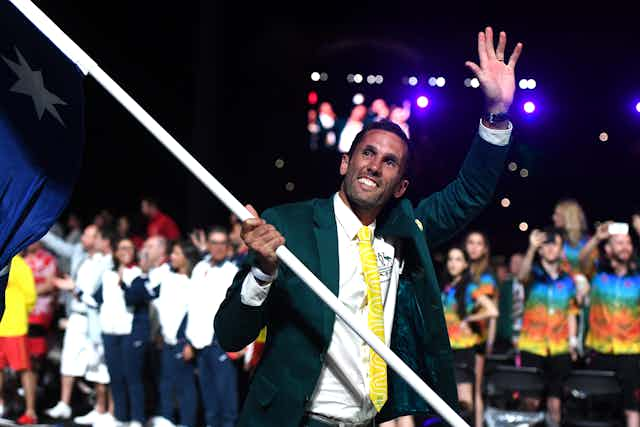Several leading Australian athletes have announced their retirement following the Commonwealth Games, including Kookaburras captain Mark Knowles and pistol shooter Bruce Quick. These are the lucky ones who are able to choose their own time to leave what has been a dominant part of their life.
Many athletes struggle with joblessness, depression or a lack of purpose as they enter retirement. The key is to help athletes develop into well-rounded people, so that their identities do not rest entirely on their sporting prowess.
The issue is not a new one, of course. George Best, the great Irish footballer, provides just one example of a star who found himself adrift when his football genius was taken away. This led to a sad decline and a premature death.
Read more: Former Olympic athletes can battle anxiety, depression
For most athletes, sports success occurs at a time in life when they are just developing a sense of their personal identity.
But to emerge as an adult with a strong sense of personal identity and confidence usually requires opportunities to explore different sides of our personalities. However, an unremitting program of training and competition demands an athlete’s total commitment.
In the case of the young athlete, their early success and lack of opportunity to explore alternative dimensions of themselves can result in what has been called “identity foreclosure”. This is the act of committing to an identity prematurely, without exploration or choice.
The result can be that athletes rely excessively on their identities as sportspeople. When this is later taken away, they suffer an extraordinary sense of loss and difficulty finding satisfactory meaning in their life and sense of worth.
Following her retirement, swimming great Libby Trickett talked about her struggles with depression:
When you are training 35 hours a week you can eat a lot. When you’re not training 35 hours a week, I could eat like I was training at that Olympic level. I put on a lot of weight, had no routine, stopped all forms of exercise.
I stopped wanting to catch up with friends and family. What do you talk about now, you know?
I had nothing outside of swimming, really. You know, I tried to create something outside of swimming, so I was doing university, but it wasn’t necessarily a passion.
Meeting the challenge
An athlete like Mark Knowles should be well equipped for a successful transition into retirement. He has the roles of husband and father to continue with, a position in his state academy of sport and a sport-related business to develop.
In other words, Knowles has been able to develop and maintain identities alongside his identity as an elite athlete.
But there are other athletes who have not had the resources to support this sort of concurrent personal development,or whose training, competition and other sport-related demands have squeezed out opportunities for interactions with family, age peers outside their sport, study and leisure time.
A number of the programs that seek to assist athletes make the transition into a post-athletic life, such as the International Olympic Committee Athlete Career Education Program, concentrate on directing retiring athletes towards education, finding a new career and developing life skills.
While such programs are very helpful and have been developed with great expertise, they are essentially remedial in nature. They aim to redress deficits in the individual that should not have occurred.
Read more: How athletes such as Eamon Sullivan cope with retirement
The aim at every stage in the athletic career should be to focus on the development of the whole person rather than just the athletic person.
Recently, the world of athletics mourned the passing of the first man to break the four-minute-mile barrier, Sir Roger Bannister. This watershed was achieved while Bannister was pursuing postgraduate medical studies at Oxford.
He went on to a distinguished career as a neurosurgeon and was later appointed master of Pembroke College. In addition, he found time to contribute as a sports administrator, becoming the first chairman of the British Sports Council in 1972.
While such levels of achievement in disparate fields will always be exceptional, the dangers of allowing a sense of personal identity and self-worth to be dependent on any one single domain are self-evident.
Well-rounded athletes
The responsibility for athlete development lies ultimately with the sports themselves and the institutions that work with them. Some sports have developed infrastructures to support holistic development.
The AFL Players’ Association, for example, has responded to its own research findings by implementing its Max360 program. This explicitly aims to help players with their holistic development away from the footy field. Its stated focus is on the players’ current engagement and development off the field, as opposed to a “preparing for life after football” narrative.
Forty-one universities across Australia have combined with the Australian Sports Commission, the state institutes of sport and the national governing bodies of sport to form the Elite Athlete Friendly Universities network. The program serves to encourage and help athletes to remain in contact with their academic studies and development. More flexible arrangements are available to athletes, which enables them to reconcile many of the conflicts between their sporting and academic programs.
In the world at large, the nature of jobs and careers is changing from that of predictable career pathways to looking more like a sequence of often loosely connected “gigs”.
In the future many individuals, not just sportspeople, may need to take up a completely new career at the ages of 30 or 40. What becomes important is that our sports heroes arrive at that point not at a disadvantage but at least equally as prepared as their new competitors from outside the sporting world. The only way to ensure that is by commitment to the holistic development of our athletes right from the outset and throughout their athletic careers.

